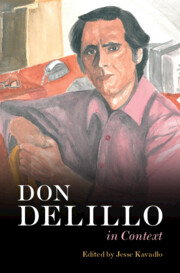Book contents
- Don DeLillo In Context
- Don DeLillo In Context
- Copyright page
- Contents
- Contributors
- Acknowledgments
- Abbreviations
- Introduction: Context, Content, Conflict
- Part I Places
- Part II History and Politics
- Part III Media and Pop Culture
- Chapter 10 Film
- Chapter 11 Television and Mass Media
- Chapter 12 Plays and Performance
- Chapter 13 Sports
- Chapter 14 The Internet
- Chapter 15 Signs
- Part IV Literary Contexts
- Part V Material Contexts
- Part VI Social and Cultural Constructions
- Part VII Writing and Writers
- Further Reading
- Index
- References
Chapter 15 - Signs
Print, Image, and Digital Media in DeLillo
from Part III - Media and Pop Culture
Published online by Cambridge University Press: 19 May 2022
- Don DeLillo In Context
- Don DeLillo In Context
- Copyright page
- Contents
- Contributors
- Acknowledgments
- Abbreviations
- Introduction: Context, Content, Conflict
- Part I Places
- Part II History and Politics
- Part III Media and Pop Culture
- Chapter 10 Film
- Chapter 11 Television and Mass Media
- Chapter 12 Plays and Performance
- Chapter 13 Sports
- Chapter 14 The Internet
- Chapter 15 Signs
- Part IV Literary Contexts
- Part V Material Contexts
- Part VI Social and Cultural Constructions
- Part VII Writing and Writers
- Further Reading
- Index
- References
Summary
In the epoch of global capitalism, writers must be hypervigilant to the usage of their medium of choice –the written, printed word – readily aware of the proliferation of the grapheme and the saturation of visual signage in the media environment. Product advertisements that once depended on the enlarged-type appeal of slogans invariably stating the brand name have given way to an iconic Esperanto, equally legible to anyone around the globe. As a literary author, Don DeLillo recognizes that the image in our visual culture has become the dominant medium of our time. Despite this displacement of the writer from a central position in mass culture, DeLillo’s novels, such as White Noise, Mao II, and Underworld offer considerations as to how the post-war author might evade absorption by visual media and global capitalism, and whether it is possible to maintain a resistant, if marginalized, position in society.
- Type
- Chapter
- Information
- Don DeLillo In Context , pp. 144 - 152Publisher: Cambridge University PressPrint publication year: 2022

